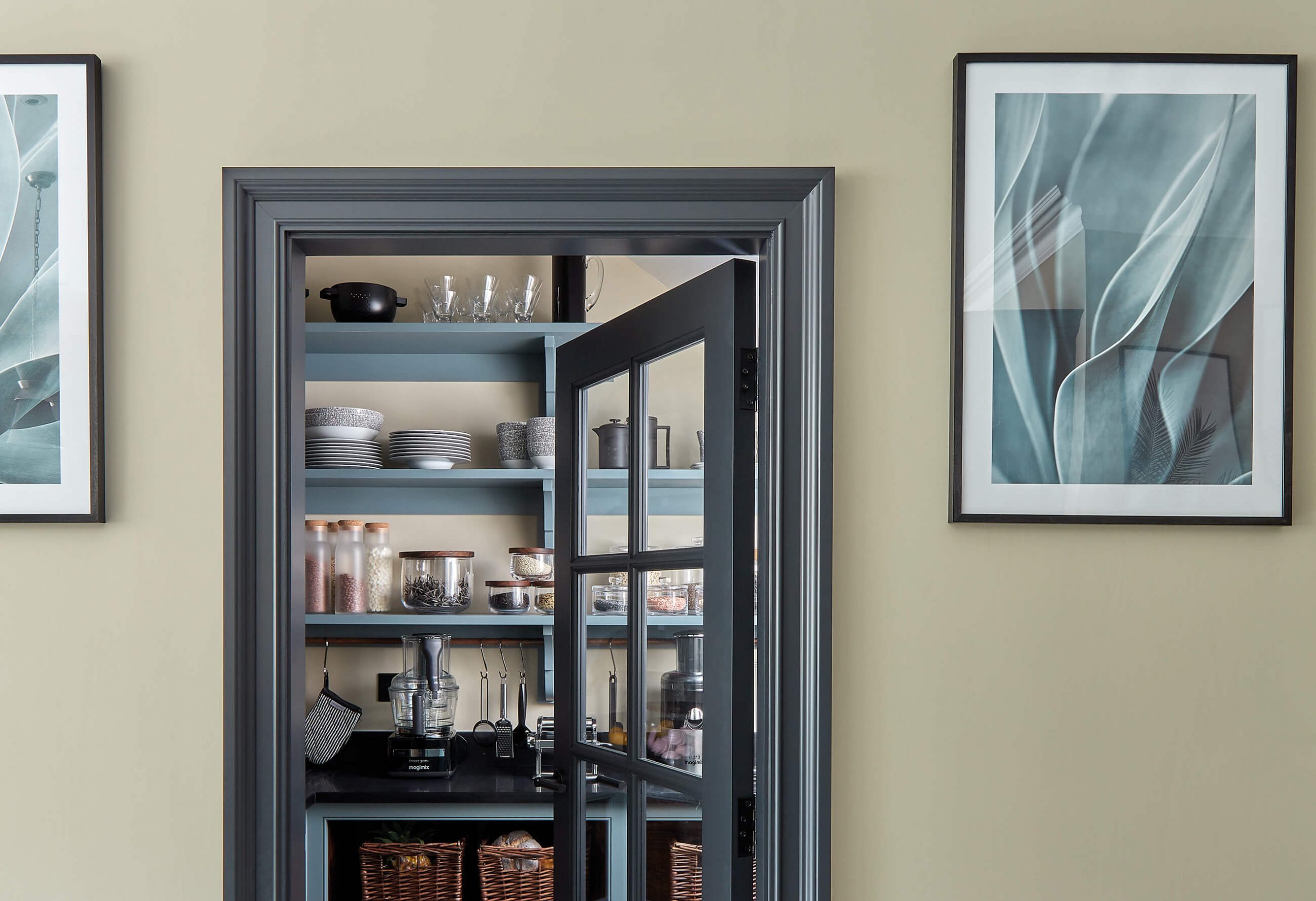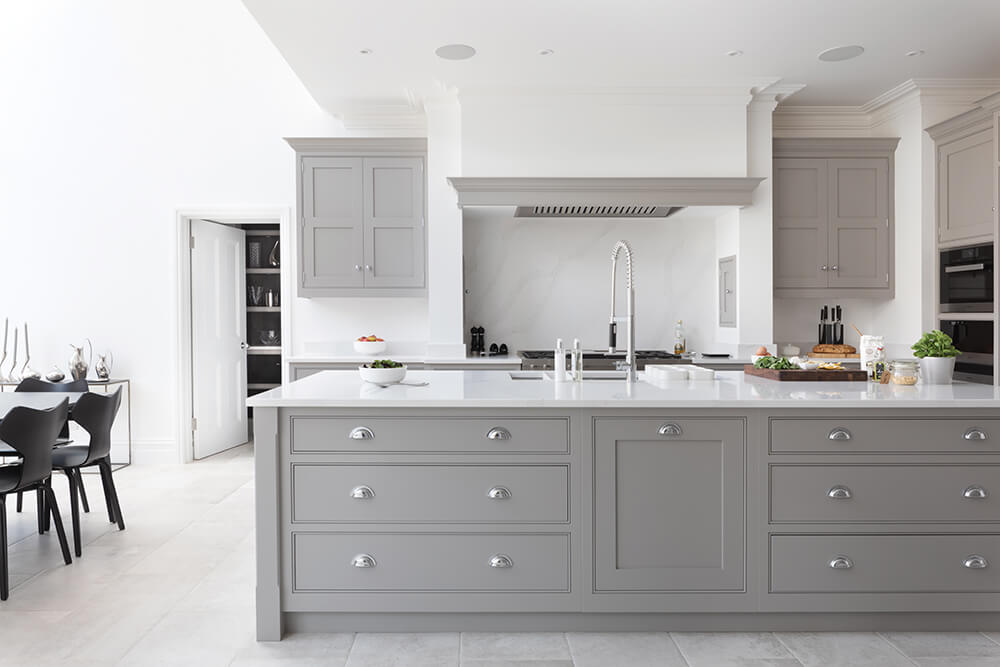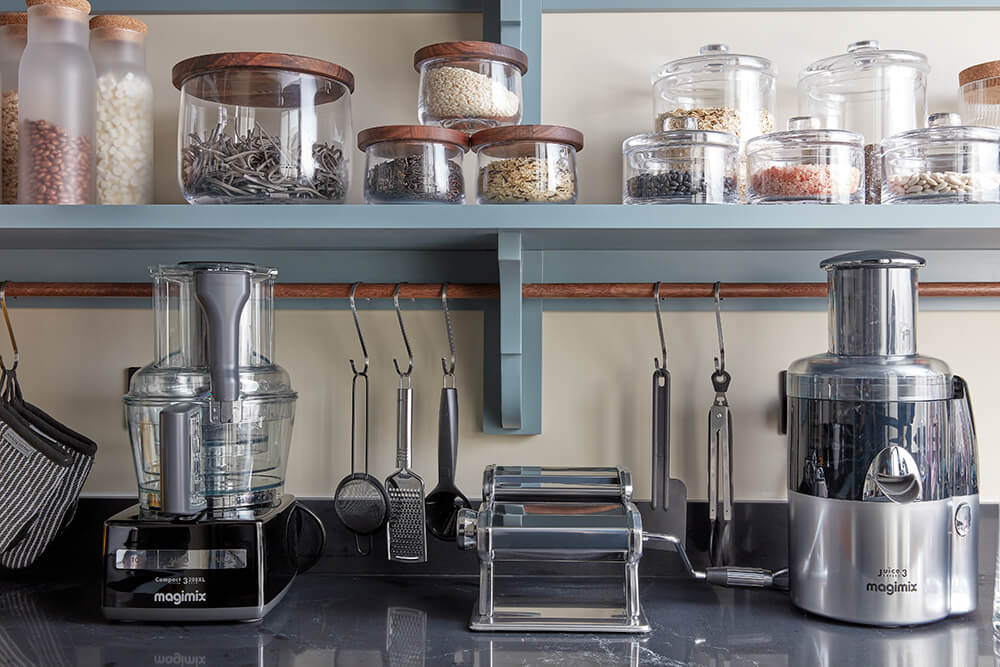

Taking pressure off the kitchen, the walk-in pantry is fast becoming one of the most desired features in the home.
They can be tailored to your needs, whether you want a space to keep appliances, hoard refillable jars, store fresh ingredients, or simply hide the mess that often clutters the kitchen. With so many possibilities in terms of storage, design and organisation, we thought we’d share a few fundamental rules to help you make the most of this highly functional space.
Whatever the size, a pantry is a worthwhile element to consider when designing your kitchen. As mentioned in a recent KBBFocus feature, Design Director Tom Howley suggests that the first port of call when planning a walk-in pantry is to consider how much space can be allocated to it. This will determine the overall layout of the design – straight line, L-shape or U-shape. If you’re tight for room, opt for pocket or sliding doors, this will maximise floor space and create easy access to essential zones. Walkway and appliance clearances should also be considered to ensure there’s plenty of room to manoeuvre.
Over the past year, you’ve probably grown to realise how vital well-designed rooms are in the home, particularly the kitchen. This space has to serve multiple functions and work efficiently to suit your lifestyle. Hence, it’s no surprise that there is now a significant focus on practicality, multifunctionality and streamlined storage.

Similarly to your main kitchen, when designing a walk-in pantry, you should think about its everyday practical requirements, how it will function, and what you will store there. You should also draw up a list of elements that you may need in the future, ensuring your walk-in pantry has longevity. You might involve more drawers or put an emphasis on shelving, all orderly contained behind doors.
Traditionally placed downstairs in large English country homes and originally named the ‘butlers pantry’, this space was used to store cooking essentials, fine silverware and valuable ingredients. Developing over the years, the walk-in pantry eventually became an integral part of every home, with modern designs positioned within close proximity to the primary kitchen work zones.
Your walk-in pantry should be a natural extension of the kitchen with a mixture of shelving, drawers and work surface space. In terms of positioning, you should also consider ventilation and temperature to ensure the longevity of your food.
With so much accessible space and versatility when it comes to food storage, a pantry can bring order to the busiest of environments. We suggest incorporating a mix of intelligent storage solutions, from deep drawers and bespoke racking to open shelving and utensil rails. A well-positioned quartz countertop can be a godsend, not only for storing small appliances but as a space to unpack the shopping and stash deliveries until they are put away.
To maximise available space, consider running shelves or cabinets all the way to the ceiling for additional storage. Different heights of shelving should be used to allow easy access to both smaller and more bulky items. Shallow shelves are perfect for spices and cereal, while sturdy oak shelving is a good option for holding the weight of jars and tins. Remember not to incorporate shelving that is too deep, as this tends to lead to overstacking, causing food wastage in the long run.
Installed on the underside of floating shelves, rails can be an ideal place to hang your favourite utensils, so they’re ready to use at a moment’s notice. This simple storage solution can free up drawer space, accommodating other kitchenalia needing a home.
As soon as you step foot into your walk-in pantry, you should be able to grab what you need with ease. This is why pull-out storage is a must, giving you easy access to everyday essentials. You can allocate space for deep drawers or even baskets, perfect for storing fresh produce such as onions and potatoes, loaves of bread and baking goods that need to be kept cool and dry.
We believe that a walk-in pantry should be both beautiful and functional. Our designs are expertly crafted and made from robust materials, ensuring each pantry design meets the demands of modern living. Handcrafted dovetail drawers are just one of the inspiring features you’ll find in a Tom Howley pantry. Not only are they functional, but they can also be configured and beautifully finished in a material that fits with the overall aesthetics of your space.
Design Director Tom Howley suggests, ‘From a decorative perspective, choose finishes for the external and internal cabinetry that work together to create a contrast, whether subtle or striking. If your cabinetry is deep green or soft black, choose a smoky wood finish for the internal shelving for a stylish edge. If your cabinetry is crisp white or cream, you could opt for a contrasting warm oak finish for the racks and shelving within.’
Having designated zones within your walk-in pantry will allow you to efficiently store and organise items. Group similar everyday objects together in the easy-to-reach middle section of your pantry.
Decanting dried goods such as pasta, grains, and flour into containers is an excellent option if you have open storage. Storing ingredients this way allows you to throw out bulky packaging, freeing up room in your pantry. Also, remember to label everything, which will make your life easier when it comes to grabbing the ingredients you need.

We can all be tempted by food bargains but try to resist ‘stocking up’ if it means your cupboards will be cluttered with items you don’t really need. Filling your kitchen pantry to the brim makes it difficult to see what you have, leading to wastage. It’s a good idea to bring any existing foodstuffs to the front of your cupboard and pack away your most recently bought items at the back. That way, you can organise produce by date and use everything up before it expires.
Task lighting is a must in a walk-in pantry as these spaces often lack natural light. Consider LEDs within open shelving or beneath wall cabinetry to illuminate worktops. Motion sensor lights are also a great hassle-free solution, providing light when you need it.
Glazed partitioning doors are excellent, especially if you have little to no natural light within your walk-in pantry. Half glazed doors are our preferred option as you can still show off your beautiful cabinetry and let light flow without showcasing too much clutter and kitchen paraphernalia.
Explore more beautifully bespoke kitchen storage ideas by requesting a free brochure today or book a free design visit to see how we can turn your ideas into reality.